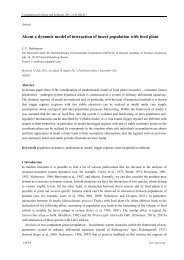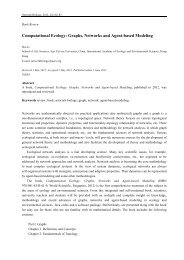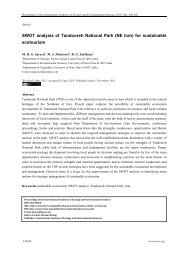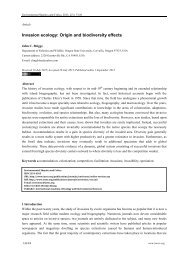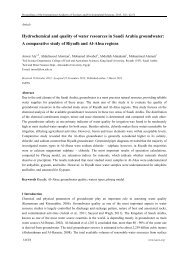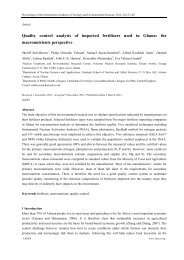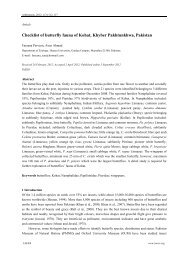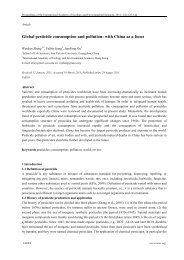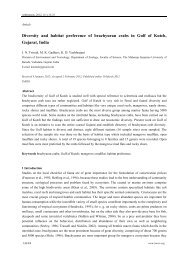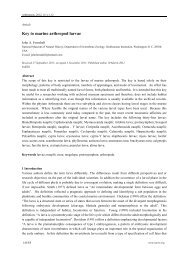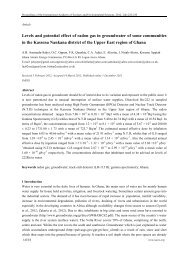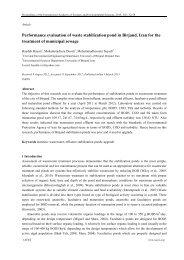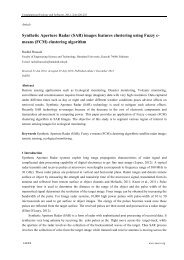Measuring competition in plant communities where it is difficult to ...
Measuring competition in plant communities where it is difficult to ...
Measuring competition in plant communities where it is difficult to ...
Create successful ePaper yourself
Turn your PDF publications into a flip-book with our unique Google optimized e-Paper software.
Computational Ecology and Software, 2011, 1(3):125-137<br />
127<br />
compet<strong>it</strong>ive mechan<strong>is</strong>ms <strong>in</strong> natural <strong>plant</strong> <strong>commun<strong>it</strong>ies</strong> have been <strong>in</strong>ferred from compar<strong>in</strong>g <strong>plant</strong> <strong>commun<strong>it</strong>ies</strong><br />
at different successional stages, the so-called “space for time subst<strong>it</strong>ution” (Barclay-Estrup and Gim<strong>in</strong>gham,<br />
1969; Bakker et al., 1996). F<strong>in</strong>ally, for test<strong>in</strong>g specific ecological hypotheses, <strong>it</strong> may be <strong>difficult</strong> <strong>to</strong> f<strong>in</strong>d natural<br />
<strong>plant</strong> <strong>commun<strong>it</strong>ies</strong> w<strong>it</strong>h the required variation <strong>in</strong> the <strong>in</strong><strong>it</strong>ial cond<strong>it</strong>ions and <strong>it</strong> has, therefore, become<br />
<strong>in</strong>creas<strong>in</strong>gly popular <strong>to</strong> study the mechan<strong>is</strong>m of <strong>compet<strong>it</strong>ion</strong> <strong>in</strong>directly by observ<strong>in</strong>g changes <strong>in</strong> synthetic or<br />
experimental <strong>plant</strong> <strong>commun<strong>it</strong>ies</strong> (Fukami et al., 2005; Ejrnæs et al., 2006; Fridley et al., 2007).<br />
The development of <strong>in</strong>direct methods for <strong>in</strong>ferr<strong>in</strong>g <strong>in</strong>terspecific compet<strong>it</strong>ive relationships has had a central<br />
role <strong>in</strong> the <strong>in</strong>creas<strong>in</strong>g awareness of the importance of l<strong>in</strong>k<strong>in</strong>g ecological data w<strong>it</strong>h quant<strong>it</strong>ative population<br />
models by means of advanced stat<strong>is</strong>tical approaches (Rees et al., 1996; Clark, 2007). However, <strong>in</strong> order <strong>to</strong> test<br />
specific hypotheses on the role of <strong>plant</strong> <strong>compet<strong>it</strong>ion</strong> <strong>in</strong> determ<strong>in</strong><strong>in</strong>g <strong>plant</strong> commun<strong>it</strong>y structures, <strong>it</strong> <strong>is</strong> necessary<br />
<strong>to</strong> make a direct l<strong>in</strong>k between the spatial arrangement of neighbour<strong>in</strong>g <strong>plant</strong>s and <strong>plant</strong> performance. Such<br />
direct studies of the importance of <strong>compet<strong>it</strong>ion</strong> have been performed under the head<strong>in</strong>g of neighbourhood<br />
analyses, <strong>where</strong> the effect of the d<strong>is</strong>tance between neighbour<strong>in</strong>g <strong>plant</strong>s on <strong>plant</strong> performance <strong>is</strong> quantified.<br />
Pacala and Silander (1990) described the commun<strong>it</strong>y dynamics between two annual <strong>plant</strong> species <strong>in</strong> a<br />
neighbourhood analys<strong>is</strong>, and Turnbull et al. (2004) estimated the <strong>in</strong>dividual-level <strong>compet<strong>it</strong>ion</strong> coefficients for<br />
seven annuals grow<strong>in</strong>g <strong>in</strong> limes<strong>to</strong>ne grassland over 2 years. However, the method of neighbourhood analys<strong>is</strong> <strong>is</strong><br />
only feasible <strong>in</strong> <strong>plant</strong> <strong>commun<strong>it</strong>ies</strong> that are dom<strong>in</strong>ated by <strong>plant</strong> species <strong>where</strong> <strong>it</strong> <strong>is</strong> easy <strong>to</strong> d<strong>is</strong>t<strong>in</strong>gu<strong>is</strong>h<br />
<strong>in</strong>dividual <strong>plant</strong>s, and many open natural herbal and grassland <strong>commun<strong>it</strong>ies</strong> are dom<strong>in</strong>ated by perennial species<br />
that form dense vegetation <strong>where</strong> <strong>it</strong> <strong>is</strong> <strong>difficult</strong> <strong>to</strong> d<strong>is</strong>t<strong>in</strong>gu<strong>is</strong>h <strong>in</strong>dividual <strong>plant</strong>s and, consequently, <strong>to</strong> determ<strong>in</strong>e<br />
dens<strong>it</strong>y. Furthermore, if <strong>in</strong>dividual <strong>plant</strong>s may be d<strong>is</strong>t<strong>in</strong>gu<strong>is</strong>hed, they almost always vary markedly <strong>in</strong> size, so<br />
that the number of neighbour<strong>in</strong>g <strong>in</strong>dividuals w<strong>it</strong>h<strong>in</strong> a certa<strong>in</strong> d<strong>is</strong>tance <strong>is</strong> of lim<strong>it</strong>ed value for describ<strong>in</strong>g the<br />
amount of <strong>compet<strong>it</strong>ion</strong> experienced by the target <strong>plant</strong>. More generally, the degree of <strong>compet<strong>it</strong>ion</strong> experienced<br />
by the target <strong>plant</strong> <strong>is</strong> expected <strong>to</strong> be species-specific spatial functions (<strong>compet<strong>it</strong>ion</strong> kernels or field-ofneighbourhoods)<br />
that depend cr<strong>it</strong>ically on the size and d<strong>is</strong>tances of the neighbour<strong>in</strong>g <strong>plant</strong>s (Berger and<br />
Hildenbrandt, 2000), and such field-of-neighbourhoods are not easily estimated <strong>in</strong> <strong>plant</strong> <strong>commun<strong>it</strong>ies</strong> w<strong>it</strong>h<br />
several species.<br />
In th<strong>is</strong> paper a novel method for measur<strong>in</strong>g <strong>compet<strong>it</strong>ion</strong> <strong>in</strong> und<strong>is</strong>turbed natural <strong>plant</strong> <strong>commun<strong>it</strong>ies</strong> <strong>is</strong><br />
d<strong>is</strong>cussed. The method allows direct measurements of the compet<strong>it</strong>ive effects of neighbour<strong>in</strong>g <strong>plant</strong>s on <strong>plant</strong><br />
performance and the estimation of parameters that describe the ecological processes of <strong>plant</strong>-<strong>plant</strong> <strong>in</strong>teractions<br />
dur<strong>in</strong>g the grow<strong>in</strong>g season as well as the process of survival and recru<strong>it</strong>ment between grow<strong>in</strong>g seasons us<strong>in</strong>g<br />
data from a standard p<strong>in</strong>-po<strong>in</strong>t analys<strong>is</strong> (Damgaard et al., 2009). In a p<strong>in</strong>-po<strong>in</strong>t analys<strong>is</strong>, a frame w<strong>it</strong>h a fixed<br />
grid pattern <strong>is</strong> placed above the vegetation. At each grid po<strong>in</strong>t, a p<strong>in</strong> <strong>is</strong> <strong>in</strong>serted vertically <strong>in</strong><strong>to</strong> the vegetation<br />
and the number of times the p<strong>in</strong> <strong>to</strong>uches different <strong>plant</strong> species <strong>is</strong> recorded (Levy and Madden, 1933; Kent and<br />
Coker, 1992). A p<strong>in</strong>-po<strong>in</strong>t measurement provides estimates of two important <strong>plant</strong> ecological variables: cover<br />
and vertical dens<strong>it</strong>y. The species cover <strong>is</strong> the relative area that a species “covers” when projected on<strong>to</strong> the twodimensional<br />
ground surface and, <strong>in</strong> a p<strong>in</strong>-po<strong>in</strong>t analys<strong>is</strong>, cover <strong>is</strong> estimated by the relative number of p<strong>in</strong>s that<br />
<strong>to</strong>uch the species. It <strong>is</strong> argued that cover <strong>in</strong> many open perennial <strong>plant</strong> <strong>commun<strong>it</strong>ies</strong> will be a more su<strong>it</strong>able<br />
predic<strong>to</strong>r of the compet<strong>it</strong>ive <strong>in</strong>teractions than local <strong>plant</strong> dens<strong>it</strong>y. The vertical dens<strong>it</strong>y <strong>is</strong> def<strong>in</strong>ed as the number<br />
of times a s<strong>in</strong>gle p<strong>in</strong> h<strong>it</strong>s a specific species (for a d<strong>is</strong>cussion on term<strong>in</strong>ology see Wilson, 2011), th<strong>is</strong> measure <strong>is</strong><br />
pos<strong>it</strong>ively related <strong>to</strong> the 3-dimensional space occupancy (or volume) of the species and has been shown <strong>to</strong> be a<br />
non-l<strong>in</strong>ear function of <strong>plant</strong> biomass (Jonasson, 1983, 1988). For most <strong>plant</strong> species, both the cover and the<br />
vertical dens<strong>it</strong>y will be relevant measures of the ecological success of the species (Damgaard et al., 2009).<br />
IAEES<br />
www.iaees.org



